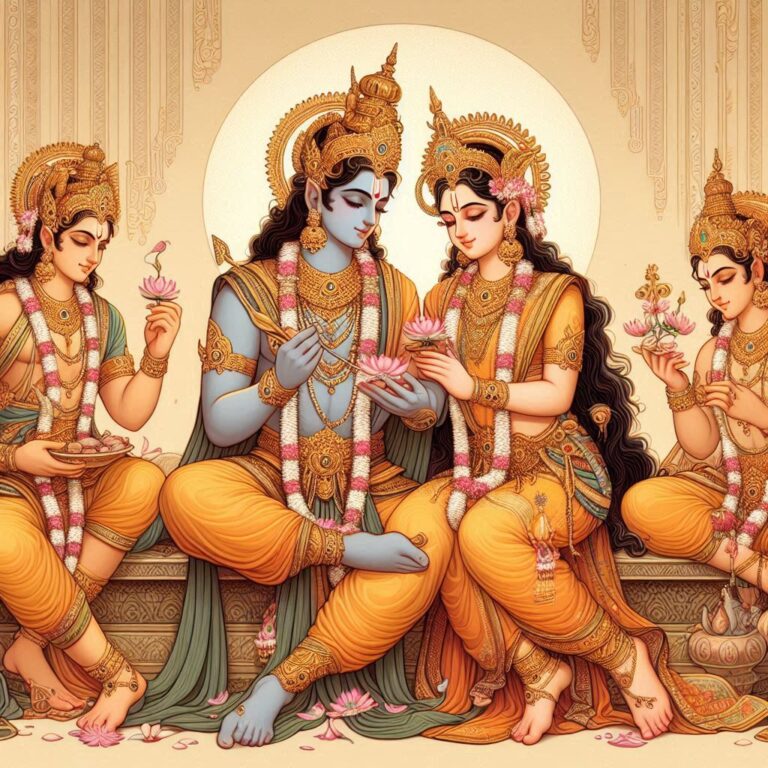Understanding Karma’s Role and Impact in the Ramayana
Understanding Karma in the Ramayana
Karma: a word virtually every one of us has heard of, yet few truly understand its depth and implications, particularly in epic texts like the Ramayana. So, let’s embark on a journey through this age-old philosophy and discover how it relates to the timeless tale of Rama, Sita, and the epic battle between good and evil.
What is Karma?
Before diving into the Ramayana, let’s get a grip on what karma really means. Simply put, karma encapsulates the idea that every action has consequences—both good and bad. It’s like planting seeds in a garden. The seeds you sow will determine the type of plants that grow. So, think twice before you act!
Now, this concept can be boiled down to four main tenets:
- Law of Cause and Effect: Your current actions influence your future.
- Moral Responsibility: You are accountable for your deeds.
- Cycle of Rebirth: Good and bad karma can affect your incarnation in future lives.
- Universal Justice: Ultimately, the universe balances things out.
Now that we’ve laid out the groundwork of karma, let’s tie it into the fabric of the Ramayana.
The Ramayana: A Brief Overview
The Ramayana, one of India’s two great epics (the other being the Mahabharata), tells the story of Lord Rama, his wife Sita, and his loyal companion Hanuman. It isn’t just a story of love and adventure; it’s a deep exploration of ethics, duty (dharma), and karma. It paints a vivid picture of how decisions, actions, and moral obligations shape the courses of our lives.
In the Ramayana, every character’s actions, whether noble or villainous, ripple through the narrative, illustrating the multidimensional dimensions of karma. The decisions made by Rama, Sita, Ravana, and others provide a rich tapestry that allows us to reflect on our own lives.
Key Characters and Karma
Lord Rama
Rama epitomizes dharma—the ideal man. He plays by society’s rules, demonstrates profound respect for his father, and upholds righteousness. His adherence to dharma generates positive karma that assists him in overcoming multiple obstacles, including the formidable Ravana.
While Rama is the hero we adore, the tough choices he must make—like sacrificing his love for Sita or going into exile—raise intriguing questions. They prompt us to ponder: is strict adherence to duty worth the personal sacrifice?
Sita
Sita, the virtuous heroine, often represents the ideal woman. However, her trials and tribulations invite us to consider the nature of resilience and courage. Her loyalty to Rama, despite her kidnapping, imparts lessons on standing firm in the face of adversity. The karma she cultivates through loyal devotion ultimately leads her back to Rama, showcasing the triumph of good over evil.
Ravana
Now, let’s switch gears and delve into the antagonist, Ravana. A learned and powerful king, his overwhelming pride and unethical hunger for Sita lead him astray. Ravana’s actions—driven by desire—bring about his downfall. His fate teaches us that intelligence coupled with poor choices creates negative karma that can haunt us indefinitely.
Hanuman
Don’t forget the lovable Hanuman! His unwavering loyalty and immense strength play a crucial role in aiding Rama. Hanuman’s actions exemplify the essence of bhakti (devotion), emphasizing how good intentions and noble deeds can buoy one’s karmic debt.
The Cycle of Karma in the Ramayana
Now, let’s talk about how karma dictates the cycle of events in the Ramayana. The decisions made by each character set forth a tidal wave of reactions, leading to outcomes that align with their actions. The epic illustrates that karma isn’t just about what you do; it’s about the intention behind those actions.
For instance, when Rama is banished from his kingdom, one could well argue that this was a result of his father’s promise—another instance of how karma works at a larger scale. Actions taken by those in Rama’s life ripple outwards, establishing a chain reaction that transcends the individual.
Do we Have Control?
You might be wondering whether we control our karma. That’s a nuanced question! While we can steer our actions and intentions, the outcomes can depend on numerous factors, including the actions of others. Karma teaches us about our interconnections within a larger web of existence, akin to how a pebble dropped in a pond creates ripples far and wide.
The Broader Implications of Karma in Daily Life
Karma’s teachings extend beyond ancient texts. They manifest in our everyday lives, nudging us towards self-awareness.
How to Cultivate Good Karma
So how can one actively cultivate good karma? Here are a few practical suggestions:
Positive Actions: Engage in acts of kindness, be it helping others or simply sharing a smile.
Mindful Intentions: Approach decisions with genuine positive intent—it’s the thought that matters!
Forgiveness: Holding onto grudges creates negative karma. Letting go liberates both the self and the other.
Compassion: Be compassionate in your interactions; empathy often opens the door to understanding.
A Little Reflection
Have you ever caught yourself thinking, “What goes around comes around”? That’s karma talking! Recognizing that our actions have consequences is the first step toward meaningful living. It’s like navigating through life’s maze—the choices we make shape our journey, sometimes in ways we didn’t see coming.
Conclusion
The concept of karma interwoven through the Ramayana teaches us profound lessons about life, duty, and the moral ramifications of our actions. Each character, be they hero or villain, embarks on their journey laden with choices that illuminate the stark realities of cause and effect.
Understanding karma can help us navigate our lives with intention. The beauty of the Ramayana lies in its ability to resonate across generations, inspiring us to bring forth our best selves. So the next time you ponder your actions, remember: we are but seeds in the cosmic garden of existence—plant wisely.
FAQs
What is the essence of karma in the Ramayana?
Karma in the Ramayana illustrates that every action has consequences, shaping the characters’ destinies and the narrative itself.
How does Rama embody the concept of karma?
Rama’s adherence to dharma leads to positive karma that assists him in overcoming obstacles, showing how virtue leads to eventual triumph.
What lessons do Sita and Ravana teach us about karma?
Sita’s devotion demonstrates resilience and the power of good karmic actions, while Ravana is a cautionary tale of how unchecked desires can lead to negative karma.
Can karma be changed?
While we cannot change past karma, we can influence our future by making positive choices and embodying constructive actions.
How can we cultivate better karma in our lives?
By engaging in kindness, approaching decisions mindfully, practicing forgiveness, and showing compassion, we can build a reservoir of positive karma.
Don’t forget that your journey is an epic tale in itself! You can craft the narrative, just like the characters in the Ramayana.








